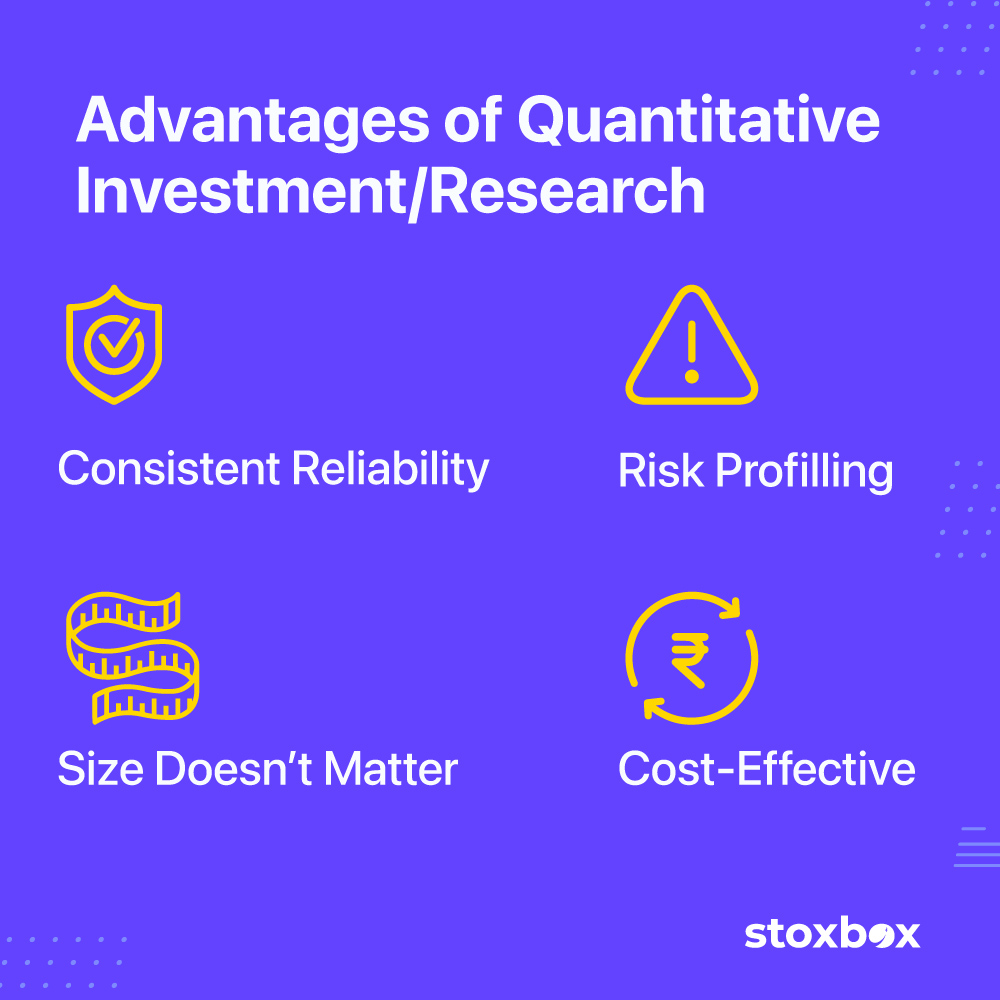You will come across two words repeatedly when you look at investment strategies: quantitative and qualitative. These terms refer to the two main methods of research, analysis, and investment strategies. Even though this article will focus on just the quantitative aspect, let’s start with simple definitions for these terms.
Quantitative research
It refers to research conducted by collecting and analyzing data. The analysis and investment strategy will therefore be data-driven. Here’s an example that will clarify this further: What will India’s population be in the 18 to 49 age group in 2050? The answer will simply depend on the current birth and mortality rates, historical birth rates, and infant mortality rates; that is, all quantifiable data.
Qualitative research
It is research done by analyzing non-numerical factors and metrics, such as interviews, videos, focus groups, and questionnaires. Here’s an example: A company decides to test whether a new snack it has developed will work in the market. It sets up a focus group of a hundred random people. After tasting the snack, it asks them to fill in a questionnaire. In this case, the market research depends on each focus group member’s notion of the quality of the snack. Therefore, qualitative feedback becomes qualitative data.
The quantitative research vs. qualitative research debate is long and full-blooded. The two simple examples above should give you a reasonable understanding of how qualitative research fares versus quantitative research and where each research strategy is better applied.
When is research considered quantitative?
In finance and investing, quantitative research and analysis (QA) happen when quantitative analysts, also called quants, use statistics and mathematics to analyze a stock or any other financial instrument’s value to determine how it will behave in the future. It uses historical market and stock data to make these determinations. These analysis points are then used to create trading algorithms that will inform their computer models, and thus, their investment decisions.
Why is quantitative research important?
Quantitative research in finance is crucial to make sense of the overwhelming amount of data created by the markets. From price to earning (P/E) ratios to cash flows and moving averages to stochastic oscillators, every statistical trend or anomaly will make sense only through intense quantitative research concerning what they show and what it means. Quants do not care about a company’s products, board make-up, or corporate social responsibility (CSR) metrics. They look at the company stock’s data to help the company decide on the position it wants to take on that stock.
When to choose a quantitative research strategy
A quantitative research strategy is viable for any endeavor requiring data crunching, numerical responses, and numerical results. The census is an excellent example of quantitative research, as it collates data from all across the country and comes up with various quantitative trends and conclusions. Policymakers will then use these quantitative trends and conclusions to decide on the qualitative aspects of policy.
What is a quantitative investing strategy?
QA and quants came into vogue when trading became computer-based. It allowed quants to crunch large amounts of data in minute bits of time to generate trends and stress points. This would then influence their trading positions, entry and exit points, profit-booking, and other investment decisions. Any strategy that depends on such procedures can be called a quantitative investing strategy. The classic example is that of making trades according to trading volume patterns. In this strategy, the quant finds a correlation between a share’s price and its trading volume. The moment it hits ₹120, its trading volume rises. You also find that once it hits ₹150, trading volume tapers off. The quant can now set up an automatic buy at ₹125 and an automatic sell at ₹145.
The quant could use any other metric to set up trading positions, such as P/E, earning per share (EPS), and earnings forecasts.
What is a quantitative investment strategy?
Multiple well-known quantitative investment strategies have been developed over the years, such as smart beta, risk premia, statistical arbitrage, factor-investing, and, of late, AI and big data strategies. Each of these strategies considers various factors, including risk, time, and returns. These are all quantitative metrics.
Of these, let’s look at smart beta strategies in detail. They are long-term strategies; that is, more of investment than frequent-trading strategies. A smart beta strategy creates an alternative index (or indexes) to the benchmark index. The difference between the two is that the smart beta index is weighted more toward a single or a group of similar factors.
For instance, the BSE Sensex is a market-capitalization-weighted index of 30 stocks on the BSE. A smart beta index would reweight this index toward P/E, which will generate better price-to-earnings performance indicators of the stocks. For a P/E dependent quant strategy, this specific smart beta index will be invaluable. They are also called custom indexes.
Advantages of Quantitative Investment/Research

Some key advantages or benefits of quantitative investment/research are,
Consistent reliability
Quant investing is done via computers, so there is no scope for emotions or sentiment. The computer takes in the research data and, per the algorithm, comes up with a strategy. It results in reliable and consistent investment decisions.
Size doesn’t matter
A quant relies on incredibly complex mathematical models and algorithms that are used by computers to trade or invest. The model could be applied to a limited or a larger set of stocks or any other applicable financial instrument. Size does not matter; the algorithm does.
Risk profiling
A large amount of crunched historical data means that the computer can set up numerous specific risk profiles that match investors to their required risk appetites.
Cost-effective
Since the computer provides investment advice based on the algorithm, human analysts need not do the same job.
Conclusion
Like any investment strategy, quant investing and quantitative research and analysis have their limitations. But where do we use quantitative research? Since it is a pure numbers-driven game, QA is not good at predicting major inflection points, like the 2008 financial meltdown. However, the principles of QA are strong. Any commitment from your side as an investor needs to be complete, up-to-date, and knowledgeable. BP Wealth has several thematic investment portfolios called Stoxboxes that use our expertise in quant investing for investors.
You might also Like.
No posts found!
